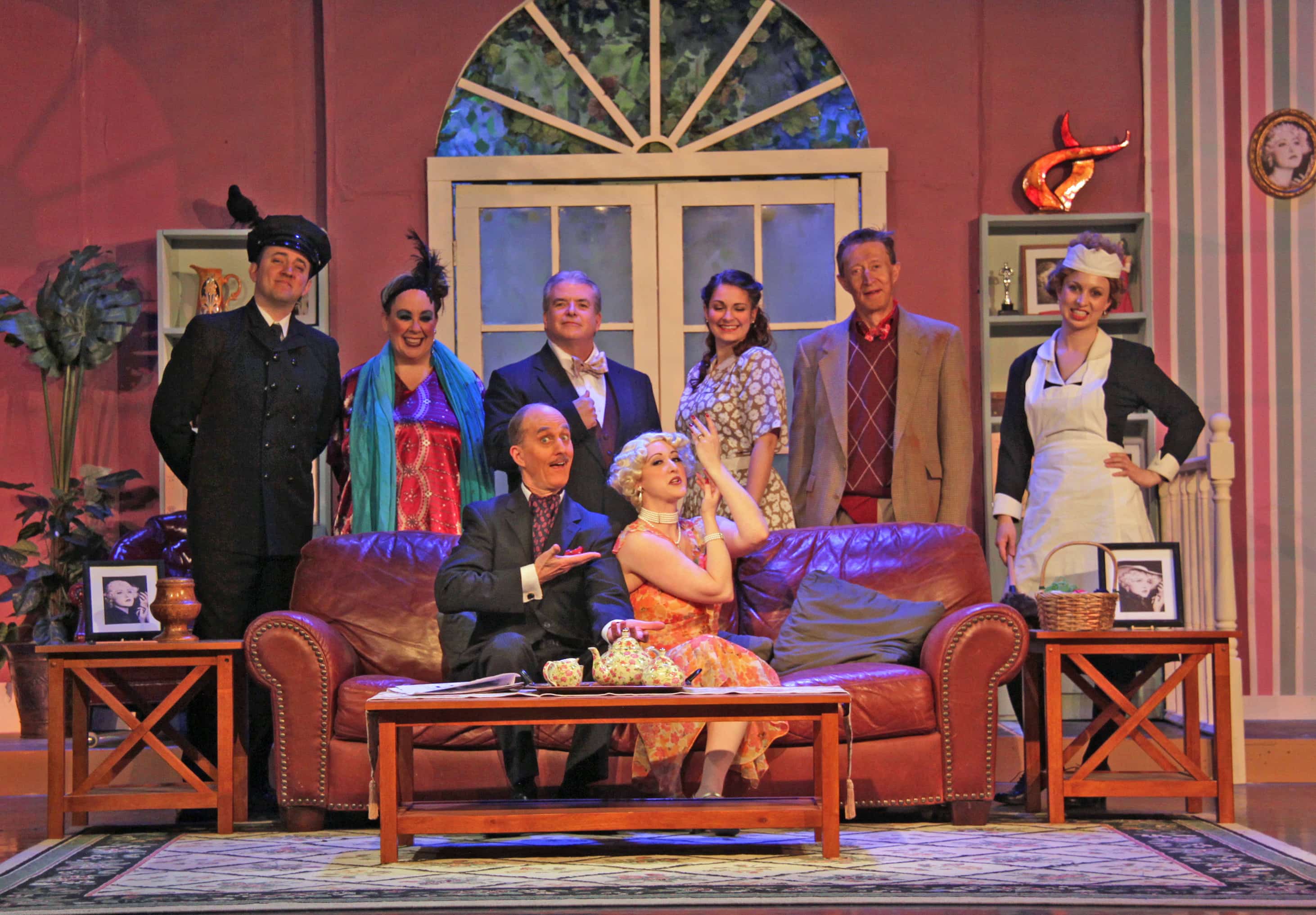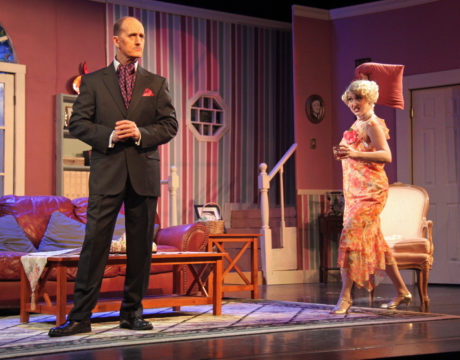“There is nothing whatever beneath my exterior.” So proclaims a character in Death by Design, now playing at the Aldersgate Church Community Theater (ACCT) in Alexandria. How right he is, not only for him but for this theatrical trifle itself. Look elsewhere for subtlety or subtext.

But it is an amusing trifle. Playwright Rob Urbinati’s concept for this comedy/mystery was to create a mashup of Noel Coward and Agatha Christie. Per Coward, there’s a bickering couple who express their chronic discord in a blizzard of witticisms, snarks, and clever ripostes. Per Christie, there’s a clever detective to stand in for Hercule Poirot or Miss Marple. Coward is better served in Act 1 than Christie in Act 2, which carries a heavy load of exposition.
The scene of the early 1930s action is the country home of Edward and Sorel Bennett. Edward (James McDaniel) is a playwright who grinds out – what else — theatrical trifles, consoling himself with their chronic commercial success. Edward misses no opportunity to demean his wife’s acting ability. James McDaniel’s take on the role includes a few too many mock-dramatic poses, as though the character lacks confidence in the ability of his own droll wit to carry the day. His timing is fine throughout.
The ditzy diva Sorel (Heather Norcross) misses no opportunity to point out the repetitive shallowness of Edward’s scripts, longing for the sort of serious dramatic role that is well beyond her range. With her high voice and flailing gestures, Sorel at times calls to mind Singing in the Rain’s Lina Lamont. Norcross portrays nicely the underlying affection she feels for her husband and does a nicely gradual drunk bit toward the end of Act 2.

The script makes a frequent point that the Bennetts’ conflicts are physical as well as verbal. Edward has thrown Sorel to the floor and pushed her down the stairs, and Sorel has punched Edward and nailed his head with a well-aimed vase (he first appears with a bandage on his forehead). In this production, Sorel takes an additional vase to hurl at Edward offstage following their final exit. Even given that the combat between the Bennetts is mutual and that this is a period comedy, playing domestic violence for laughs has likely become more problematic since 2011, when the play was first produced.
The other permanent members of the Bennett household are Jack (Erik Rieloff), a chauffeur and self-proclaimed ladies’ man, and Bridgit (Emily Golden), an uber-insolent maid (Downton Abbey’s Mr. Carson would not approve), who is clearly the brains of the outfit. Both are accent roles – Cockney and Irish, respectively. The actors pull off the accents well, though at the cost of making some of their lines hard to understand, especially in their opening scene. Jack has the most relaxed comic demeanor among the cast, adding to his effectiveness. Bridgit’s quick, decisive movement matches her quick, incisive mind.
Into this happy household comes a parade of oddballs. First to appear is Walter Pearce, a prissy, hypocritical, Conservative M.P. Elected on a platform of enforcing morality, he hopes for a weekend assignation with Sorel. Larry Grey accomplishes his task in the role, which is to make Walter so obnoxious as to give the other characters ample motive to do him in.
Next up is Eric (Cal Whitehurst), a far-left radical who has recently fled a mental asylum. Whitehurst is more than sufficiently antic and disheveled to give his character the intended effect. Shortly afterward appears Victoria, an Isadora Duncan-like modern dancer (scarf and all). This is a role meant to be taken as far over the top as possible, and Elizabeth Replogle does not hesitate to go to the called-for extremes. Finally, there is Alice (Carol Jean Clark), as nervous, nearsighted, and whiny an aspiring assassin as one could ask for.
After this set-up, it falls to Bridgit in Act 2 to tease out the other characters’ motives and opportunities for murder. One by one, in classic whodunit fashion, she eliminates suspects, until….
Eddie Page’s direction emphasizes the physical comedy possibilities of the play, sometimes overshadowing the verbal byplay. There are some fun bits, as when Alice pulls various items of clothing from her satchel as she searches for her glasses. There is also a tendency to repeat jokes, however. Alice finds the victim’s body falling over on her on the sofa repeatedly and has to keep pushing it off. Shortly afterward, Sorel does the same. When Walter first appears, Sorel pulls him on top of her to make out on the sofa (implausible, as Sorel would likely crave adulation and ego-stroking far more than a quickie with a highly unappealing man). Then she does it again. What’s funny once is not necessarily funny a second time. The blocking is more static than need be at times, confining actors to the sofa or a particular quadrant of the stage for minutes at a time (e.g., Victoria downstage right in Act 1).
The technical side of the production is excellent. Page’s set design is both functional and attractive, and the set dressing (Charles Dragonette) is just fussy enough to fit the Bennetts’ lifestyle. A period Victrola and a theater poster of Sorel particularly caught my eye. Among the costumes (Susan Boyd), Sorel’s orange floral dress, Victoria’s gaudy shift, and Eric’s comically mismatched outfit stood out. The lighting (Marzanne Claiborne) is mostly straightforward, its signal moment being the low-light sequence at the end of Act 1.
The outstanding element of the entire production is Janice Rivera’s sound design. It starts with the period pre-show music, notably including a number sung by Coward himself. She includes ominously dramatic sounds, reminiscent of old-time radio detective shows, as the homicidal plot unfolds. There are individual musical mini-motifs as characters enter to murder the victim at the end of Act 1, tailored to each character and precisely timed to each entrance. In Act 1, Edward mentions clearing a room with a recording of Ethel Merman singing “I’ve Got Rhythm.” After the curtain calls, as the room is indeed emptying out, Rivera serenades the departing audience with Ethel Merman singing “I’ve Got Rhythm.” Perfect. I hope the WATCH judges will be listening.
Running Time: Two hours and 15 minutes, including one 15-minute intermission.
Death by Design plays through March 25 at ACCT, 1301 Collingwood Road in Alexandria, VA. To purchase tickets, go online.




